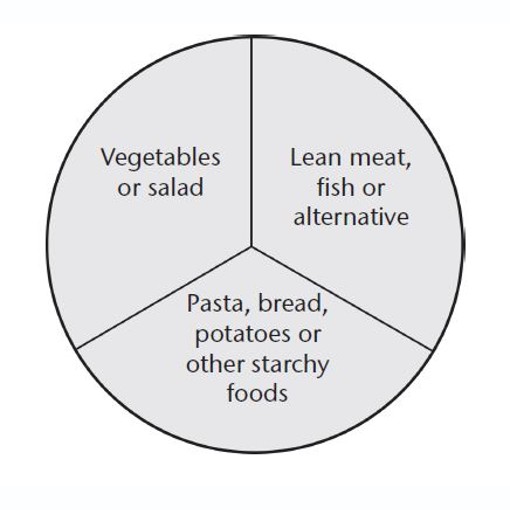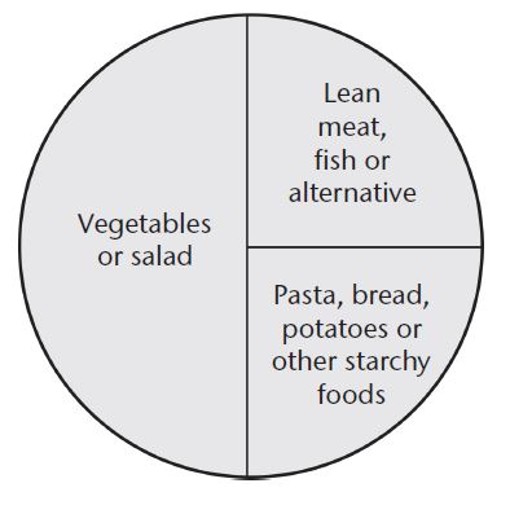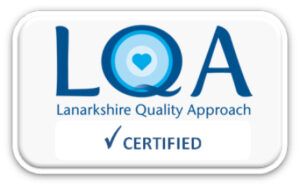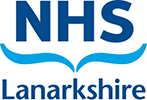Eating Healthy with Diabetes
Information for patients
NHS Lanarkshire Dietetic Department
PIL.HTHEAT.77991.L
Why is Healthy Eating Important?
Healthy eating is important for everyone’s health especially if you have diabetes. This is because the foods you eat may affect your blood glucose levels.
To help you get started this leaflet provides some basic healthy eating information. However, you can be referred to a Dietitian for a one to one consultation or come along to a structured group education session that can provide you with more in depth knowledge about diet and diabetes.
Ask your Diabetes Team for more info.
Healthy eating includes?
1. Developing a healthy eating pattern
Having 3 balanced meals a day (breakfast, lunch and an evening meal) will help keep your blood glucose levels steady and control hunger.
If you need to eat between meals this should be limited to healthy foods such as fruit or small pot of low fat yoghurt or, as a treat, 1 biscuit.
2. Include starchy carbohydrates at meals
Starchy carbohydrates include potatoes, rice, pasta, bread and cereals. They provide fibre which can help keep your digestive system healthy and help to lower cholesterol levels.
The table below shows which carbohydrates are best and what portion sizes we should be aiming for.
| To limit | To choose | Portion sizes for ‘to choose’ |
| Sugar or honey-coated breakfast cereals, for example; Frosties, Coco Pops, sweetened muesli, sugary cereal bars. | Wholegrain breakfast cereal, for example; unsweetened muesli, branflakes, porridge, Weetabix, Shredded wheat | 30 – 40g or 2-3 handfuls of cereal or 1 sachet of original porridge. 2 Weetabix or shredded wheat all with 200ml skimmed or semi-skimmed milk. |
| Fried chips, Instant mash, roast potatoes | Boiled potatoes, new potatoes, sweet potato, Baked potato | 2 tablespoonful’s mash or sweet potato mash, 4 boiled baby potatoes, small jacket potato (size of fist). |
| Fried rice, naan breads, cheesy pasta dishes | Basmati or brown rice, brown pasta, chapatti | 2 handfuls dry rice or pasta or ½ to 1 chapatti |
| White bread or rolls | Whole grain, granary, seeded bread or rolls, seeded or wholemeal wraps or pitta bread | 2 slices of medium bread, 1 small roll, 1 large or 2 small wraps or 1 pitta bread. |
3. Eat less sugar
Blood glucose levels are likely to rise if your diet contains too much sugar.
The table below shows how to cut back on sugar and suggested serving size.
| Foods high in sugar | Choose foods low in sugar | Portion sizes for foods |
| Sugar, glucose, glucose syrup, dextrose, sucrose, icing sugar, light spoon, half spoon. Sweeteners to avoid: sorbitol, xylitol and mannitol. | Artificial sweeteners, for example, Canderel, Sweetex, Hermesetas, Splenda. | Use sparingly |
| Full sugar squash and fizzy drinks, for example Ribena, orange, Lucozade, coca cola, energy drinks, lemonade and malted drinks such as hot chocolate and Horlicks. | Diet, low calorie, sugar-free squash and fizzy drinks, for example, Ribena, orange, Diet Coke, Pepsi Max, tea or coffee with no added sugar, low calorie chocolate drinks. | To meet fluid needs daily |
| Sweets, for example, chocolate, toffee, fudge, tablet, mints, chocolate covered and cream filled biscuits, cakes, marzipan. | Plain biscuit, small chocolate covered wafer biscuit, crumpet, pancake, fruit/malt loaf, oatcake or cracker. | Rich tea x 2
Other plain or chocolate biscuits x1 Small crumpet or pancake x1 Slice of fruit/malt loaf – small piece Oatcake or cracker x3 |
| Sugar-coated or honey- coated breakfast, cereal, for example, Frosties, Sugar Puffs, Crunchy Nut cereals. | Unsweetened breakfast cereal, for example, Porridge, Weetabix, Branflakes, All-bran. | 30 – 40g bowl or 2-3 handfuls with 200mls semi-skimmed or skimmed milk. |
| Sweet pudding, for example, crumble, tarts, tinned fruit in syrup | Fresh or dried fruit, Diet or light yoghurt, sugar-free jelly, tinned fruit in natural juice. | 1 portion of fruit as a snack: small banana, 2 handfuls berries, 1 medium apple or pear. 80g is one portion. |
| Marmalade, jam, treacle, syrup or honey | Reduced sugar marmalade, or jam. | Thin scraping of all. |
4. Eat less food high in fat
Cutting back on fat in your diet will help with weight loss and can reduce the risk of heart disease. The table below suggests how to cut back on fat and provides serving sizes.
| High fat foods | Choose lower fat foods | Portion of lower fat foods |
| Butter, margarine, oil, lard, dripping | Low fat spread and oils made from unsaturated oils such as olive oil, vegetable oil, corn oil, monounsaturated spreads. | Thin spreading or teaspoon amount of all. |
| Fried foods | Grill, poach, boil, microwave or oven bake | N/A |
| Chips | Potatoes – boiled, steamed or baked | Use your hand to work out correct portion: Fist sized baked potato, 4 steamed or boiled potatoes. |
| Pies, pastries, sausage rolls, fatty meat | Lean cuts of meat, fish and chicken without the skin | 3-4 slices of meat, 1 chicken breast, 1 fillet of fish, 1 small steak (size of palm of hand). |
| Creamy sauces and dressings | Tomato based sauces | Only use allocated amount for serving as too much sauce can encourage more carbohydrates to be added to your plate. |
| Cream, mayonnaise, salad cream, full fat yoghurt, full fat milk | Low fat, 0% or fat free yoghurt and fromage frais. Semi- skimmed or skimmed milk. | Per portion: 1 x small yoghurt pot or 200ml semi-skimmed milk. |
| Full fat cheese | Reduced fat varieties of cheese, Lower fat cheese such as Edam, gouda, and cottage cheese. | 1 small match box size equals 1 portion of cheese. If adding to meals use thin slices. |
| Crisps, savoury snacks, nuts | Low fat, unsalted crisps or corn snacks, unsalted nuts | Small handful of unsalted nuts or small packet of unsalted crisps or corn snacks. |
5. Eat 5 portions of fruit and vegetables a day
Eating 5 portions of fruit and vegetables daily will help maintain a healthy digestive system.
Portion sizes:
Fruit:
- 2 handfuls berries
- 1 medium apple, peaches or pear
- 1 small banana
- 1 handful grapes
- 2 tangerines, kiwis or plums
Vegetables:
2- 3 tablespoons all vegetables or 80g if weighing on food scales.
All fruit and vegetables are suitable and they can be fresh, frozen or tinned in natural juice. Fruit should be spread throughout the day and limited to max 3 portions a day (1 portion at different times). Try to have vegetables with your evening meal. Aim to eat more vegetables than fruit however fruit still provides lots of the nutrients we need, so should be part of a healthy balanced diet.
6. Include oily fish
Oily fish contains a type of fat called omega 3 which helps protect against heart disease.
You should try to have oily fish in your diet at least once a week.
Examples are:
- sardines
- pilchards
- salmon
- mackerel
- herring
7. Eat less salt
Too much salt can raise your blood pressure which can lead to stroke and heart disease.
- Avoid adding salt at the table.
- Use as little salt as possible in cooking.
- Use herbs and spices to flavour food instead.
- Avoid processed foods and meats, tinned and packet foods.
- Do not use salt substitutes like LoSalt.
8. Healthy Weight
Body weight and diabetes are closely linked. If you are overweight it is harder for your body to use insulin properly. Weight loss of 5-10% can help you to control your blood glucose levels.
A healthy weight will also help reduce your risk of heart disease and stroke and control your blood pressure.
Aim for a realistic weight loss (1-2lbs each week). It is better to lose a small amount of weight and keep it off, than to lose a lot of weight and regain it.
9. Portion sizes
As well as looking at the types of food you eat it is important to consider your portion sizes, particularly if you are trying to lose weight.
Try to divide your plate into some starchy carbohydrate foods, vegetables and lean meat, fish, beans or alternatives.
For weight maintenance, divide your plate into
- One third: Vegetables or salad
- One third: Lean meat, fish or alternative
- One third: Pasta, bread, potatoes or other starchy foods
For weight loss, divide your plate into
- One half: Vegetables or salad
- One quarter: Lean meat, fish or alternative
- One quarter: Pasta, bread, potatoes or other starchy foods


10. Limit your alcohol intake
Most people with diabetes can enjoy an occasional alcoholic drink.
The safe amounts of alcohol for people with diabetes and the general population are exactly the same.
Men and Women are advised:
- Not to drink more than 14 units per week.
- Spread your drinking over three days or more if you drink as much as 14 units per week.
Alcohol is high in energy and may cause weight gain therefore sensible drinking is essential.
There may be some precautions you should take depending on how your diabetes is treated. See the NHS Lanarkshire leaflet Alcohol and Your Diabetes available from your diabetes team.
Exercise helps improve your general health and your diabetes control.
See the NHS Lanarkshire Leaflet Exercise and Your Diabetes available from your diabetes team.
11. Avoid foods labelled ‘diabetic’ or ‘suitable for diabetics’
There is no need to buy special “diabetic” foods. They can have a laxative effect and will not help if you are trying to lose weight. Diabetic foods may still cause your blood glucose to rise.
Review date: March 2024
Issue No: 07
Reference: PIL.HTHEAT.77991.L
22_03983
If you need this information in another language or format, please e-mail:




